2022 KIA NIRO HYBRID EV child lock
[x] Cancel search: child lockPage 164 of 684
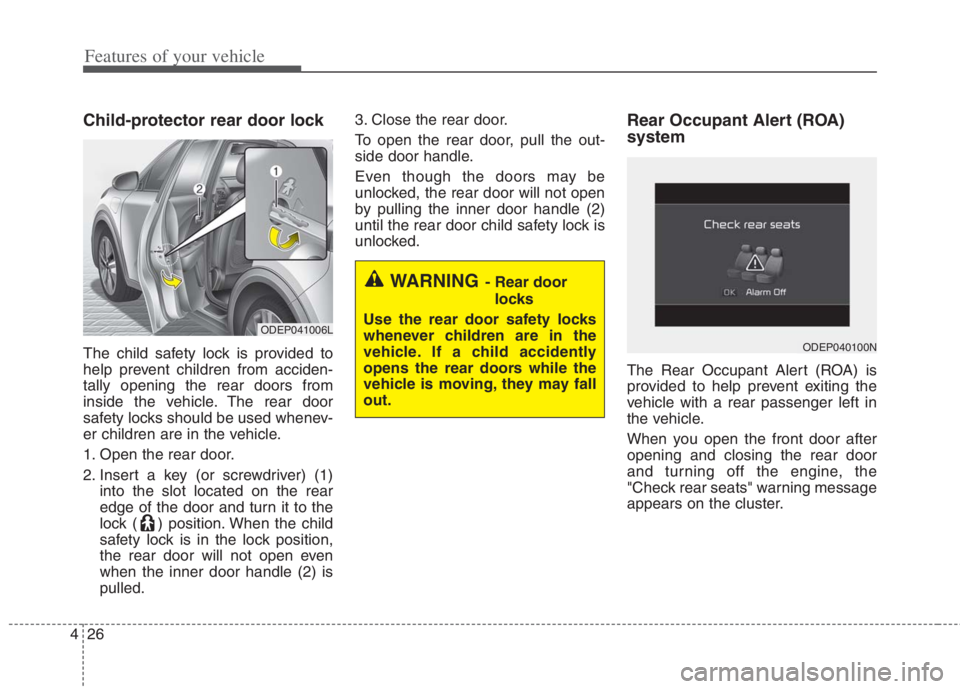
Features of your vehicle
26 4
Child-protector rear door lock
The child safety lock is provided to
help prevent children from acciden-
tally opening the rear doors from
inside the vehicle. The rear door
safety locks should be used whenev-
er children are in the vehicle.
1. Open the rear door.
2. Insert a key (or screwdriver) (1)
into the slot located on the rear
edge of the door and turn it to the
lock ( ) position. When the child
safety lock is in the lock position,
the rear door will not open even
when the inner door handle (2) is
pulled.3. Close the rear door.
To open the rear door, pull the out-
side door handle.
Even though the doors may be
unlocked, the rear door will not open
by pulling the inner door handle (2)
until the rear door child safety lock is
unlocked.
Rear Occupant Alert (ROA)
system
The Rear Occupant Alert (ROA) is
provided to help prevent exiting the
vehicle with a rear passenger left in
the vehicle.
When you open the front door after
opening and closing the rear door
and turning off the engine, the
"Check rear seats" warning message
appears on the cluster.
WARNING- Rear door
locks
Use the rear door safety locks
whenever children are in the
vehicle. If a child accidently
opens the rear doors while the
vehicle is moving, they may fall
out.
ODEP041006L
ODEP040100N
Page 165 of 684
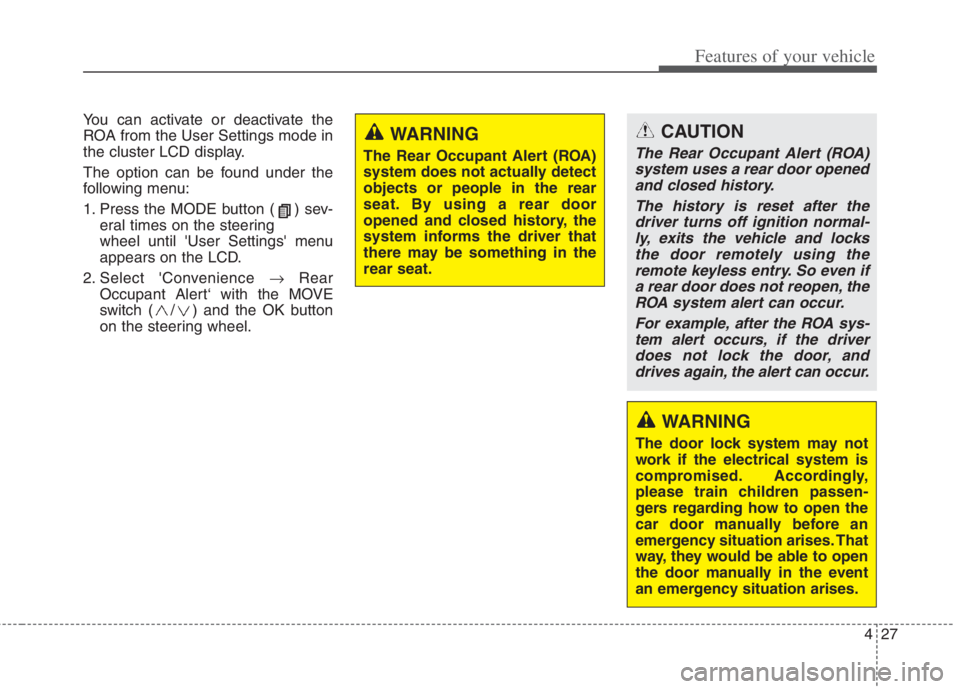
427
Features of your vehicle
You can activate or deactivate the
ROA from the User Settings mode in
the cluster LCD display.
The option can be found under the
following menu:
1. Press the MODE button ( ) sev-
eral times on the steering
wheel until 'User Settings' menu
appears on the LCD.
2. Select 'Convenience Rear
Occupant Alert‘ with the MOVE
switch ( / ) and the OK button
on the steering wheel.
WARNING
The Rear Occupant Alert (ROA)
system does not actually detect
objects or people in the rear
seat. By using a rear door
opened and closed history, the
system informs the driver that
there may be something in the
rear seat.
WARNING
The door lock system may not
work if the electrical system is
compromised. Accordingly,
please train children passen-
gers regarding how to open the
car door manually before an
emergency situation arises. That
way, they would be able to open
the door manually in the event
an emergency situation arises.
CAUTION
The Rear Occupant Alert (ROA)
system uses a rear door opened
and closed history.
The history is reset after the
driver turns off ignition normal-
ly, exits the vehicle and locks
the door remotely using the
remote keyless entry. So even if
a rear door does not reopen, the
ROA system alert can occur.
For example, after the ROA sys-
tem alert occurs, if the driver
does not lock the door, and
drives again, the alert can occur.
Page 173 of 684
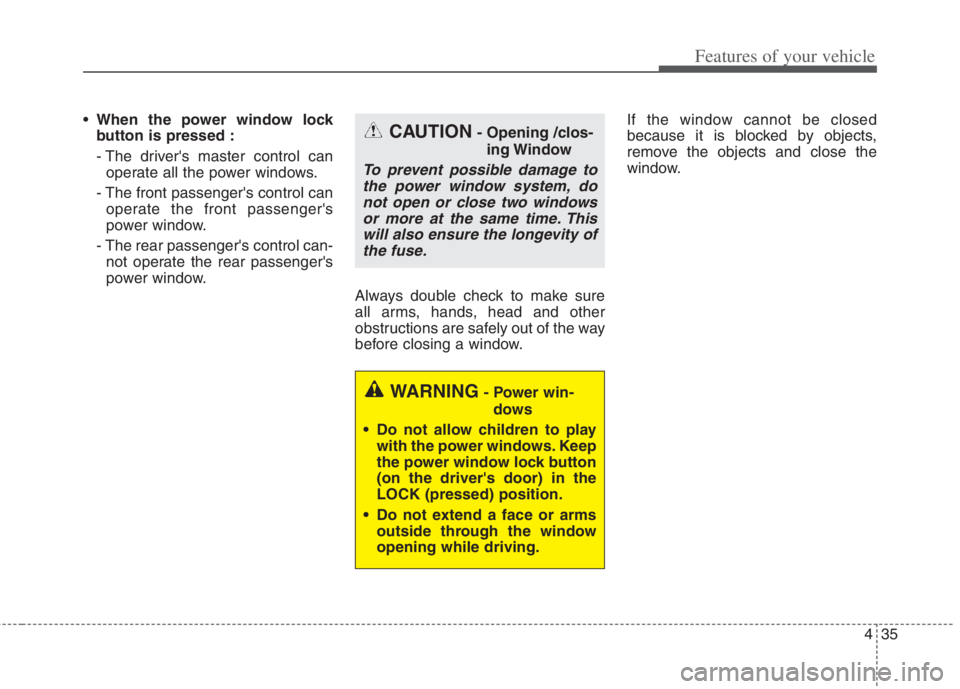
435
Features of your vehicle
When the power window lock
button is pressed :
- The driver's master control can
operate all the power windows.
- The front passenger's control can
operate the front passenger's
power window.
- The rear passenger's control can-
not operate the rear passenger's
power window.
Always double check to make sure
all arms, hands, head and other
obstructions are safely out of the way
before closing a window.If the window cannot be closed
because it is blocked by objects,
remove the objects and close the
window.CAUTION- Opening /clos-
ing Window
To prevent possible damage to
the power window system, do
not open or close two windows
or more at the same time. This
will also ensure the longevity of
the fuse.
WARNING- Power win-
dows
Do not allow children to play
with the power windows. Keep
the power window lock button
(on the driver's door) in the
LOCK (pressed) position.
Do not extend a face or arms
outside through the window
opening while driving.
Page 182 of 684
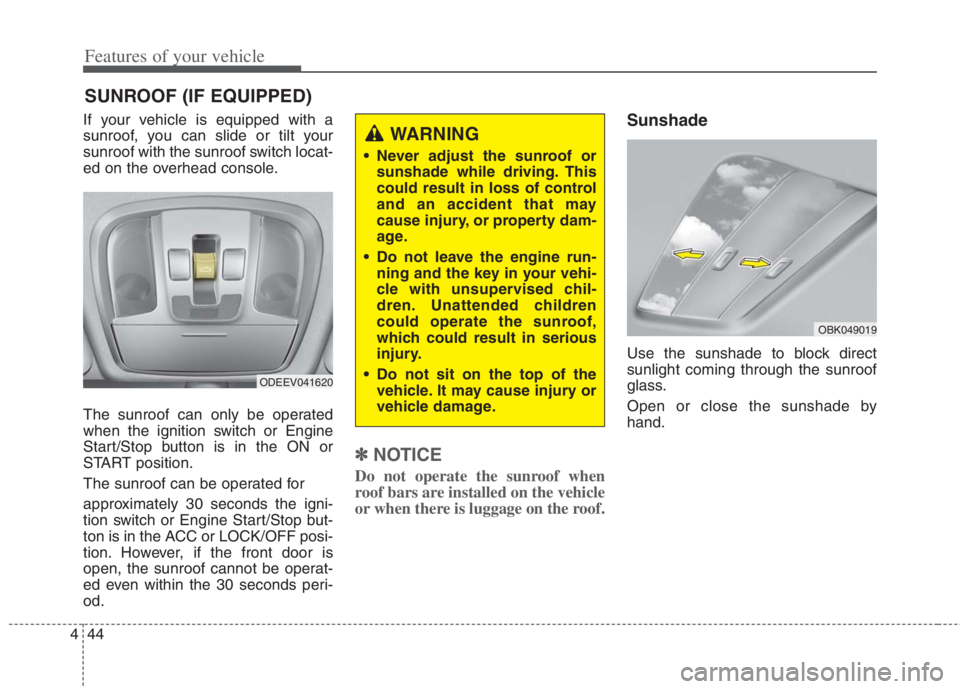
Features of your vehicle
44 4
If your vehicle is equipped with a
sunroof, you can slide or tilt your
sunroof with the sunroof switch locat-
ed on the overhead console.
The sunroof can only be operated
when the ignition switch or Engine
Start/Stop button is in the ON or
START position.
The sunroof can be operated for
approximately 30 seconds the igni-
tion switch or Engine Start/Stop but-
ton is in the ACC or LOCK/OFF posi-
tion. However, if the front door is
open, the sunroof cannot be operat-
ed even within the 30 seconds peri-
od.
✽ ✽
NOTICE
Do not operate the sunroof when
roof bars are installed on the vehicle
or when there is luggage on the roof.
Sunshade
Use the sunshade to block direct
sunlight coming through the sunroof
glass.
Open or close the sunshade by
hand.
SUNROOF (IF EQUIPPED)
ODEEV041620
WARNING
Never adjust the sunroof or
sunshade while driving. This
could result in loss of control
and an accident that may
cause injury, or property dam-
age.
Do not leave the engine run-
ning and the key in your vehi-
cle with unsupervised chil-
dren. Unattended children
could operate the sunroof,
which could result in serious
injury.
Do not sit on the top of the
vehicle. It may cause injury or
vehicle damage.
OBK049019
Page 342 of 684
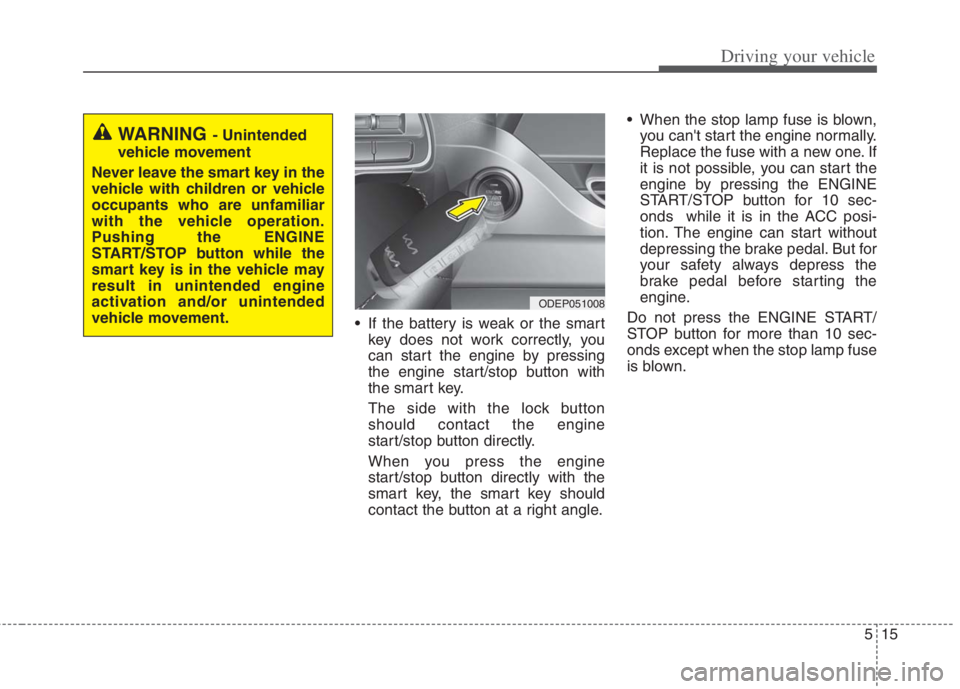
515
Driving your vehicle
If the battery is weak or the smart
key does not work correctly, you
can start the engine by pressing
the engine start/stop button with
the smart key.
The side with the lock button
should contact the engine
start/stop button directly.
When you press the engine
start/stop button directly with the
smart key, the smart key should
contact the button at a right angle. When the stop lamp fuse is blown,
you can't start the engine normally.
Replace the fuse with a new one. If
it is not possible, you can start the
engine by pressing the ENGINE
START/STOP button for 10 sec-
onds while it is in the ACC posi-
tion. The engine can start without
depressing the brake pedal. But for
your safety always depress the
brake pedal before starting the
engine.
Do not press the ENGINE START/
STOP button for more than 10 sec-
onds except when the stop lamp fuse
is blown.
WARNING - Unintended
vehicle movement
Never leave the smart key in the
vehicle with children or vehicle
occupants who are unfamiliar
with the vehicle operation.
Pushing the ENGINE
START/STOP button while the
smart key is in the vehicle may
result in unintended engine
activation and/or unintended
vehicle movement.
ODEP051008
Page 676 of 684
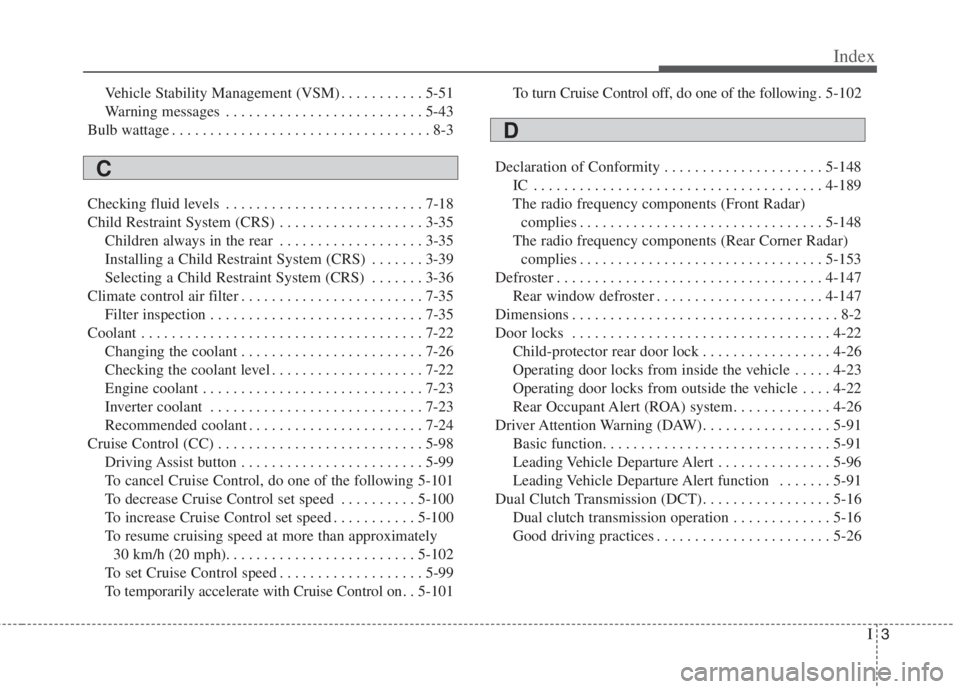
I3
Index
Vehicle Stability Management (VSM) . . . . . . . . . . . 5-51
Warning messages . . . . . . . . . . . . . . . . . . . . . . . . . . 5-43
Bulb wattage . . . . . . . . . . . . . . . . . . . . . . . . . . . . . . . . . . 8-3
Checking fluid levels . . . . . . . . . . . . . . . . . . . . . . . . . . 7-18
Child Restraint System (CRS) . . . . . . . . . . . . . . . . . . . 3-35
Children always in the rear . . . . . . . . . . . . . . . . . . . 3-35
Installing a Child Restraint System (CRS) . . . . . . . 3-39
Selecting a Child Restraint System (CRS) . . . . . . . 3-36
Climate control air filter . . . . . . . . . . . . . . . . . . . . . . . . 7-35
Filter inspection . . . . . . . . . . . . . . . . . . . . . . . . . . . . 7-35
Coolant . . . . . . . . . . . . . . . . . . . . . . . . . . . . . . . . . . . . . 7-22
Changing the coolant . . . . . . . . . . . . . . . . . . . . . . . . 7-26
Checking the coolant level . . . . . . . . . . . . . . . . . . . . 7-22
Engine coolant . . . . . . . . . . . . . . . . . . . . . . . . . . . . . 7-23
Inverter coolant . . . . . . . . . . . . . . . . . . . . . . . . . . . . 7-23
Recommended coolant . . . . . . . . . . . . . . . . . . . . . . . 7-24
Cruise Control (CC) . . . . . . . . . . . . . . . . . . . . . . . . . . . 5-98
Driving Assist button . . . . . . . . . . . . . . . . . . . . . . . . 5-99
To cancel Cruise Control, do one of the following 5-101
To decrease Cruise Control set speed . . . . . . . . . . 5-100
To increase Cruise Control set speed . . . . . . . . . . . 5-100
To resume cruising speed at more than approximately
30 km/h (20 mph). . . . . . . . . . . . . . . . . . . . . . . . . 5-102
To set Cruise Control speed . . . . . . . . . . . . . . . . . . . 5-99
To temporarily accelerate with Cruise Control on. . 5-101To turn Cruise Control off, do one of the following . 5-102
Declaration of Conformity . . . . . . . . . . . . . . . . . . . . . 5-148
IC . . . . . . . . . . . . . . . . . . . . . . . . . . . . . . . . . . . . . . 4-189
The radio frequency components (Front Radar)
complies . . . . . . . . . . . . . . . . . . . . . . . . . . . . . . . . 5-148
The radio frequency components (Rear Corner Radar)
complies . . . . . . . . . . . . . . . . . . . . . . . . . . . . . . . . 5-153
Defroster . . . . . . . . . . . . . . . . . . . . . . . . . . . . . . . . . . . 4-147
Rear window defroster . . . . . . . . . . . . . . . . . . . . . . 4-147
Dimensions . . . . . . . . . . . . . . . . . . . . . . . . . . . . . . . . . . . 8-2
Door locks . . . . . . . . . . . . . . . . . . . . . . . . . . . . . . . . . . 4-22
Child-protector rear door lock . . . . . . . . . . . . . . . . . 4-26
Operating door locks from inside the vehicle . . . . . 4-23
Operating door locks from outside the vehicle . . . . 4-22
Rear Occupant Alert (ROA) system. . . . . . . . . . . . . 4-26
Driver Attention Warning (DAW). . . . . . . . . . . . . . . . . 5-91
Basic function. . . . . . . . . . . . . . . . . . . . . . . . . . . . . . 5-91
Leading Vehicle Departure Alert . . . . . . . . . . . . . . . 5-96
Leading Vehicle Departure Alert function . . . . . . . 5-91
Dual Clutch Transmission (DCT). . . . . . . . . . . . . . . . . 5-16
Dual clutch transmission operation . . . . . . . . . . . . . 5-16
Good driving practices . . . . . . . . . . . . . . . . . . . . . . . 5-26
C
D